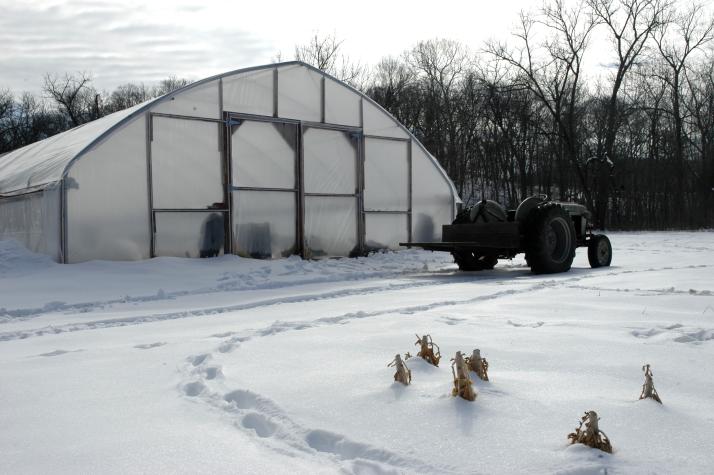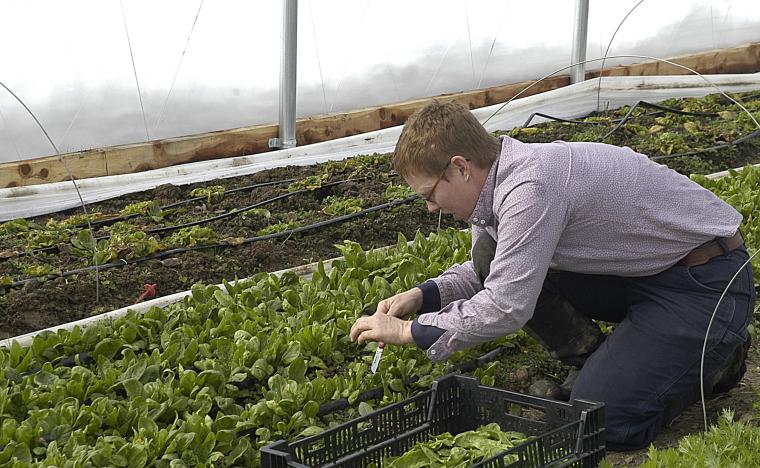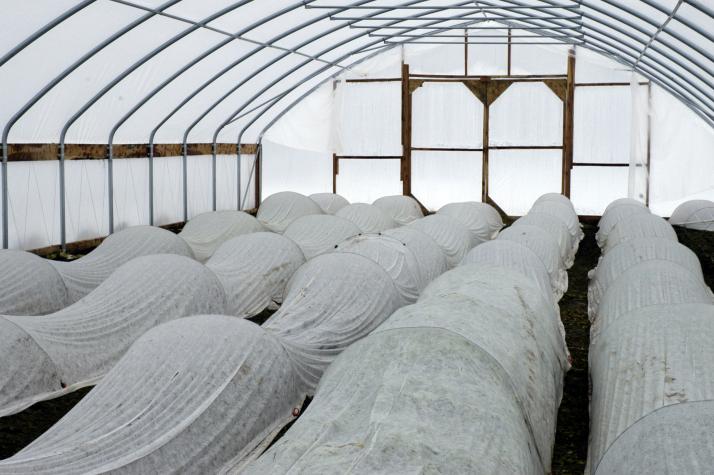High tunnels extend the growing season.
JAMESTOWN, Mo. – There’s a thick coat of snow on the ground, but Liz Graznak is harvesting lettuce, spinach and other vegetables on her central Missouri farm.
Graznak grows certified organic produce at Happy Hollow Farm, about a mile southwest of the Missouri River. She extended her growing season into the middle of winter by using a high tunnel, also known as a hoop house.
High tunnels enable horticulture producers to plant earlier in the spring and continue harvesting into or even through the winter, said James Quinn, a University of Missouri Extension horticulture specialist.
Quinn believes high tunnels will become a familiar part of the American agricultural landscape, the 21st-century equivalent of silos and red barns. They are already a common sight in many Asian and European countries.
A high tunnel is a simple type of greenhouse relying exclusively on solar heating. A shell of translucent plastic admits sunlight, traps warm air and shields crops from the elements. A layer of breathable fabric shrouds each row of plants to provide additional protection.
“A high tunnel can provide a source of income through the winter months,” Graznak said.
Graznak sells directly to consumers, who pay a flat fee up front to receive a weekly share of produce throughout the season—a system called Community Supported Agriculture. Most CSAs generally go on hiatus in the fall, but Graznak’s high tunnel let her enroll customers in a winter season that ran through mid-January.
“People really appreciate high-quality produce in the winter because it is hard to get,” she said.
Producers benefit from the extra revenue, which also gives a boost to the local economy, Quinn said.
High tunnels also can provide protection in spring and summer against excessive rainfall and other extreme weather. On warm, sunny days, you have to ventilate the tunnel, typically by rolling up the side walls. Some producers install a louvered door and a solar-powered fan at opposite ends of the tunnel to keep air flowing.
High tunnels also have environmental benefits, Quinn said, including reduced use of water and fertilizer, and decreased soil erosion.
That’s one reason the USDA’s Natural Resources Conservation Service (NRCS), through the department’s Know Your Farmer, Know Your Food initiative, started a three-year pilot project last year to help horticulture producers build high tunnels.
Graznak’s farm was one of 159 farms in Missouri and more than 2,400 farms nationwide to receive cost-sharing assistance from USDA’s Environmental Quality Incentives Program in 2010, the project’s second year. EQIP covered about $5,400 of her tunnel’s $8,500 construction cost. She also saved money on construction materials by harvesting 32 cedar trees on her farm and taking them to a local sawmill.
Since 2003, MU Extension has helped conduct educational programs on high tunnels, including a construction workshop at Graznak’s farm last October. Interest has steadily grown, Quinn said. A January workshop sponsored by NRCS drew a capacity crowd to the MU Extension Center in Boone County.
The deadline to apply for NRCS funding for the pilot project’s third and final year is March 4, Quinn said. However, additional funding may become available after 2011, pending the outcome of a review of the project by NRCS.
For more information, contact your local NRCS office or see Helping People Help the Land.
###


